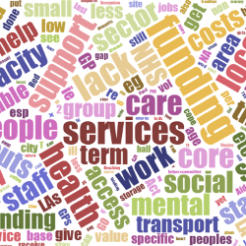Local health bodies’ engagement with the voluntary sector is too patchy according to Navca, with more than half the charities surveyed saying that they were not involved enough in the decision-making process.
Navca released the results of its Voluntary sector annual survey – Findings from the Health and Care Voluntary Sector Strategic Partnership 2014 survey this morning. Some 720 organisations, serving more than 11 million people across the United Kingdom, responded.
Of the charities - ranging in income from excess of £10m to less than £10,000 – surveyed, over 50 per cent said they were not involved in the decision making processes at a local health level, such as during Joint Strategic Needs Assessments (JSNA’s) or by Health and Wellbeing Boards. While respondents felt more positively about Clinical Commissioning Groups (CCGs), many still felt they were difficult to communicate with.
Navca’s survey also found a general apathy amongst respondents towards various national initiatives. Of a select number of national health initiatives featured in the survey, the vast majority were found to be little known or understood by respondents.
Neil Cleeveley, chief executive of Navca, said that while there were instances of local health authorities and charities working well together, there are too many areas where this isn’t happening effectively.
“It seems that despite some really good examples of local health bodies engaging charities it isn’t happening consistently across the country.
"Too many areas are missing out on the benefits of working with charities. That means missed opportunities to improve people’s wellbeing and reduce the demand on expensive acute services,” he said.
Experience of dealing with local health authorities
JSNA’s look at the current and subsequently future health needs of local populations in the hope of informing any future health and social care services in that area. As set out in the Health and Social Care Bill 2011, the voluntary sector was originally supposed to play a major role in agreeing any JSNA process but the survey results suggest this hasn’t occurred.
While over half of respondents agreed that JSNA’s are being used to decide local health priorities, only 35 per cent of respondents felt that they were involved in the process to agree with a JSNA. Some 40 per cent of respondents also felt that the local JSNA process didn’t reflect the needs of its service users.
A similar percentage of organisations expressed dissatisfaction with local Health and Wellbeing Boards. Only 32 per cent of respondents felt they could influence local boards, which aim to improve integration of various health services. "There has been some criticism," says the survey "that health and wellbeing boards are not legally required to provide a place for representation from the voluntary sector".
Only CCGs received more positive responses from respondents. Just over 50 per cent of respondents felt that CCGs engaged with organisations in order to find out about local health needs. Almost 45 per cent felt the needs of their beneficiaries were being taken into account by CCGs, as opposed to 40 per cent who disagreed.
Apathy towards the majority of national health initiatives
Respondents were also asked to say whether they felt that a select number of national health initiatives had had a positive, negative or no effect and whether they were aware of the initiative.
For 12 out of 15 initiatives named in the survey at least 30 per cent of repsondents were unaware of the existence of the initiative. Half of respondents were unaware of the Prime Minister's challenge fund, to improve access to general practice. "What does this tell us about the impact of national initiatives?" asks the survey.
It also suggests that national health initiatives that are directly associated with politicians tend to be more poorly received by the voluntary sector as a whole than other, non-partisan initiatives.
Change 4 Life, an anti-obesity campaign, was found to be both the best known national health initiative featured in the survey. One-fifth said Change 4 Life had made a positive difference in health locally, while only 12 per cent claimed to not be aware of it.








